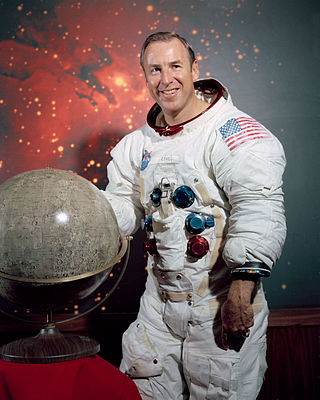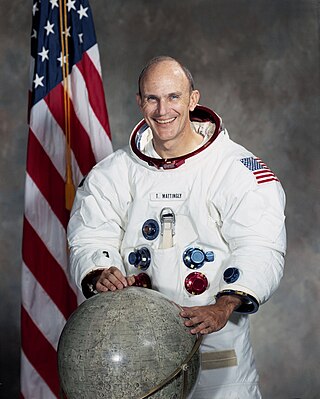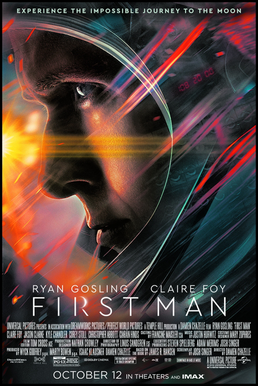
Apollo 8 was the first crewed spacecraft to leave Earth's gravitational sphere of influence, and the first human spaceflight to reach the Moon. The crew orbited the Moon ten times without landing, and then departed safely back to Earth. These three astronauts—Frank Borman, James Lovell, and William Anders—were the first humans to witness and photograph the far side of the Moon and an Earthrise.

The Apollo program, also known as Project Apollo, was the United States human spaceflight program carried out by the National Aeronautics and Space Administration (NASA), which succeeded in preparing and landing the first men on the Moon from 1968 to 1972. It was first conceived in 1960 during President Dwight D. Eisenhower's administration as a three-person spacecraft to follow the one-person Project Mercury, which put the first Americans in space. Apollo was later dedicated to President John F. Kennedy's national goal for the 1960s of "landing a man on the Moon and returning him safely to the Earth" in an address to Congress on May 25, 1961. It was the third US human spaceflight program to fly, preceded by the two-person Project Gemini conceived in 1961 to extend spaceflight capability in support of Apollo.

Apollo 13 was the seventh crewed mission in the Apollo space program and the third meant to land on the Moon. The craft was launched from Kennedy Space Center on April 11, 1970, but the lunar landing was aborted after an oxygen tank in the service module (SM) ruptured two days into the mission, disabling its electrical and life-support system. The crew, supported by backup systems on the lunar module (LM), instead looped around the Moon in a circumlunar trajectory and returned safely to Earth on April 17. The mission was commanded by Jim Lovell, with Jack Swigert as command module (CM) pilot and Fred Haise as lunar module (LM) pilot. Swigert was a late replacement for Ken Mattingly, who was grounded after exposure to rubella.

Apollo 7 was the first crewed flight in NASA's Apollo program, and saw the resumption of human spaceflight by the agency after the fire that had killed the three Apollo 1 astronauts during a launch rehearsal test on January 27, 1967. The Apollo 7 crew was commanded by Walter M. Schirra, with command module pilot Donn F. Eisele and lunar module pilot R. Walter Cunningham.

Apollo 9 was the third human spaceflight in NASA's Apollo program. Flown in low Earth orbit, it was the second crewed Apollo mission that the United States launched via a Saturn V rocket, and was the first flight of the full Apollo spacecraft: the command and service module (CSM) with the Lunar Module (LM). The mission was flown to qualify the LM for lunar orbit operations in preparation for the first Moon landing by demonstrating its descent and ascent propulsion systems, showing that its crew could fly it independently, then rendezvous and dock with the CSM again, as would be required for the first crewed lunar landing. Other objectives of the flight included firing the LM descent engine to propel the spacecraft stack as a backup mode, and use of the portable life support system backpack outside the LM cabin.

Apollo 12 was the sixth crewed flight in the United States Apollo program and the second to land on the Moon. It was launched on November 14, 1969, by NASA from the Kennedy Space Center, Florida. Commander Charles "Pete" Conrad and Lunar Module Pilot Alan L. Bean performed just over one day and seven hours of lunar surface activity while Command Module Pilot Richard F. Gordon remained in lunar orbit.

Apollo 15 was the ninth crewed mission in the United States' Apollo program and the fourth to land on the Moon. It was the first J mission, with a longer stay on the Moon and a greater focus on science than earlier landings. Apollo 15 saw the first use of the Lunar Roving Vehicle.

Apollo 16 was the tenth crewed mission in the United States Apollo space program, administered by NASA, and the fifth and penultimate to land on the Moon. It was the second of Apollo's "J missions", with an extended stay on the lunar surface, a focus on science, and the use of the Lunar Roving Vehicle (LRV). The landing and exploration were in the Descartes Highlands, a site chosen because some scientists expected it to be an area formed by volcanic action, though this proved not to be the case.

Apollo 13 is a 1995 American docudrama film directed by Ron Howard and starring Tom Hanks, Kevin Bacon, Bill Paxton, Gary Sinise, Ed Harris and Kathleen Quinlan. The screenplay by William Broyles Jr. and Al Reinert dramatizes the aborted 1970 Apollo 13 lunar mission and is an adaptation of the 1994 book Lost Moon: The Perilous Voyage of Apollo 13, by astronaut Jim Lovell and Jeffrey Kluger.

Eugene Andrew Cernan was an American astronaut, naval aviator, electrical engineer, aeronautical engineer, and fighter pilot. During the Apollo 17 mission, Cernan became the 11th human being to walk on the Moon. As he re-entered the Apollo Lunar Module after Harrison Schmitt on their third and final lunar excursion, he remains the most recent person to walk on the Moon.

David Randolph Scott is an American retired test pilot and NASA astronaut who was the seventh person to walk on the Moon. Selected as part of the third group of astronauts in 1963, Scott flew to space three times and commanded Apollo 15, the fourth lunar landing; he is one of four surviving Moon walkers and the only living commander of a spacecraft that landed on the Moon.

James Arthur Lovell Jr. is an American retired astronaut, naval aviator, test pilot and mechanical engineer. In 1968, as command module pilot of Apollo 8, he became, with Frank Borman and William Anders, one of the first three astronauts to fly to and orbit the Moon. He then commanded the Apollo 13 lunar mission in 1970 which, after a critical failure en route, looped around the Moon and returned safely to Earth.

Thomas Kenneth Mattingly II was an American aviator, aeronautical engineer, test pilot, rear admiral in the United States Navy, and astronaut who flew on Apollo 16 and Space Shuttle STS-4 and STS-51-C missions.

For All Mankind is a 1989 documentary film made of original footage from NASA's Apollo program, which successfully prepared and landed the first humans on the Moon from 1968 to 1972. It was directed by Al Reinert, with music by Brian Eno. The film, consisting of footage from Apollo 7 through Apollo 17, was assembled to depict what seems like a single trip to the Moon, highlighting the beauty and otherworldliness of the images by only using audio from the interviews Reinert conducted with Apollo crew members.

Apollo 18 is a 2011 found-footage science fiction horror film written by Brian Miller, directed by Gonzalo López-Gallego, and co-produced by Timur Bekmambetov and Michele Wolkoff. An American-Canadian co-production, its premise is that the cancelled Apollo 18 mission actually landed on the Moon in December 1974, but never returned.

First Man is a 2018 American biographical drama film directed by Damien Chazelle from a screenplay by Josh Singer, based on the 2005 book of the same name by James R. Hansen. The film stars Ryan Gosling as Neil Armstrong, alongside Claire Foy, Jason Clarke, Kyle Chandler, Corey Stoll, Christopher Abbott, and Ciarán Hinds, and follows the years leading up to the Apollo 11 mission to the Moon in 1969.
First to the Moon: The Story of Apollo 8 is a 2018 documentary film about the second crewed spaceflight mission in the United States Apollo space program, which launched on December 21, 1968. Apollo 8 was the first crewed spacecraft to leave low Earth orbit, reach the Moon, orbit it, and return safely to Earth. The film was released in December 2018 and has been screened at The Explorers Club in New York City, the Kansas Cosmosphere, and Arizona State University.

Apollo 11 is a 2019 American documentary film edited, produced and directed by Todd Douglas Miller. It focuses on the 1969 Apollo 11 mission, the first spaceflight from which men walked on the Moon. The film consists solely of archival footage, including 70 mm film previously unreleased to the public, and does not feature narration, interviews or modern recreations. The Saturn V rocket, Apollo crew consisting of Buzz Aldrin, Neil Armstrong, and Michael Collins, and Apollo program Earth-based mission operations engineers are prominently featured in the film.

















